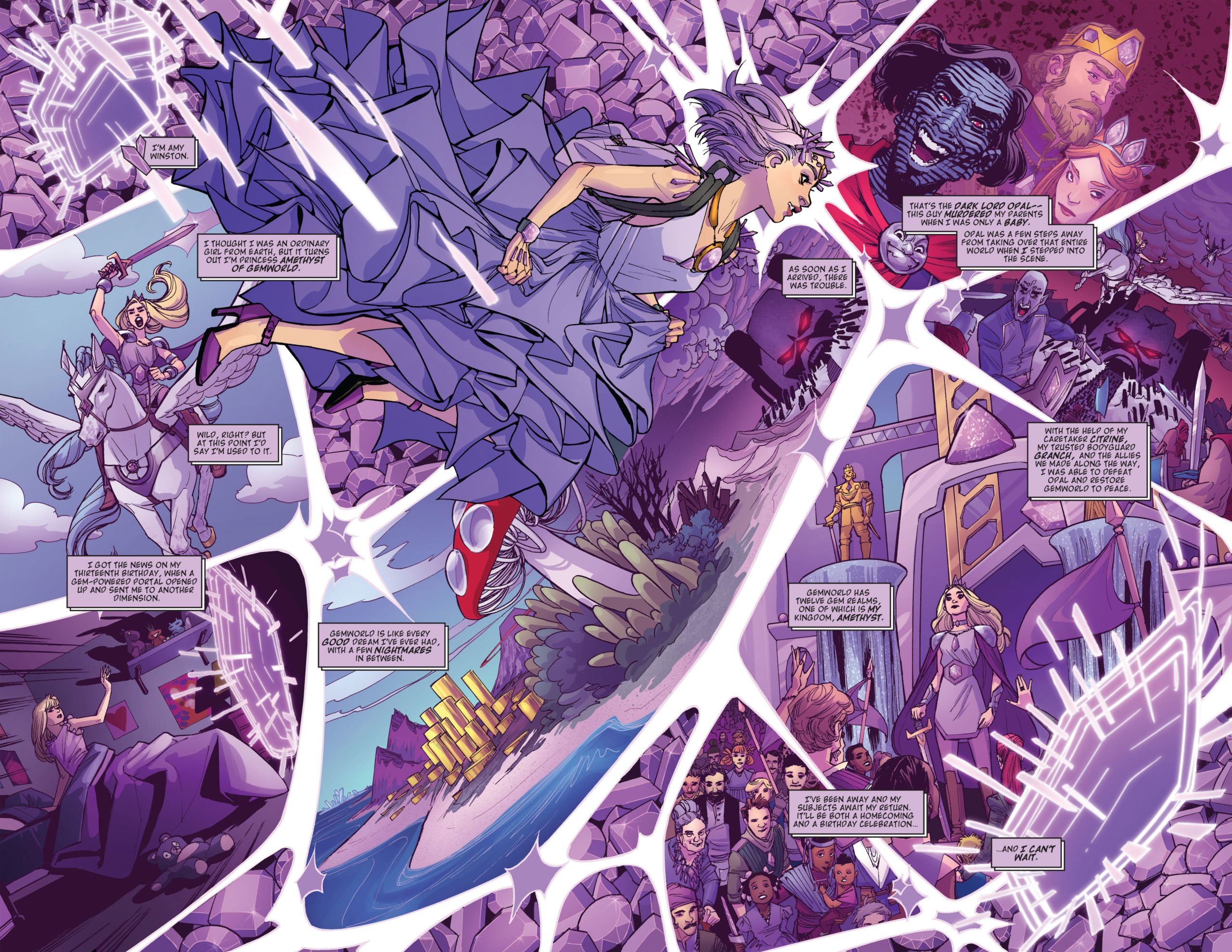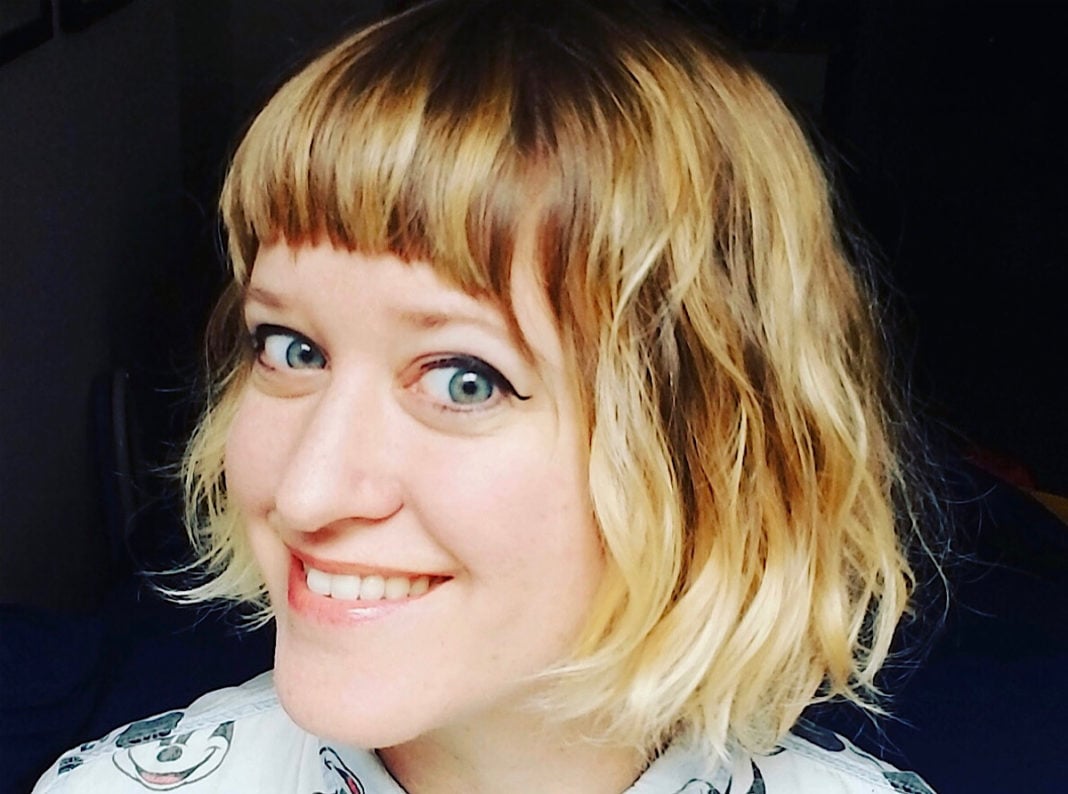There is a correct moral order to the universe in which Amy Reeder inhabits. Nowhere is this reflected more definitively than in the characters she has drawn as an artist. Dayoung Johansson in Rocket Girl, Luna Lafayette in Moon Girl and Devil Dinosaur, and now Amy Winston, also known as uber-girly Princess Amethyst. In Amethyst, Reeder puts her own personal stamp on Amy Winston as Princess Amethyst in the revival of the 1980s character created by Dan Mishkin, Gary Cohn and Ernie Colon.
Amy Winston looks forward to celebrating her sixteenth birthday with all the bells and whistles in her native Gem World. Instead, she finds the kingdom deserted and in ruins. Her allies in Turquoise have turned their backs on her. And relying on nothing more than moxy and the strength of her moral convictions, Amy forges ahead on a dangerous mission to restore right on Gemworld.
Reeder joined The Beat to talk about her evolving vision for Amethyst in the DCU.
Nancy Powell: How did you get involved with Amethyst?
Amy Reeder: Andy Khouri called me, and I guess he and Brian Bendis were trying to get me to do something over there. He had heard that I wanted to write and draw, and he also heard that I was planning to do it independently just because I kind of like being in my own world and stuff. So he was like, ‘Well, you know, maybe we can give you a lot of leeway and trust you a bit and you could do something with us.’ And he described to me the different characters that they were bringing in to the Wonder Comics line. Young Justice was going to Gemworld, and they were including Amethyst. She’s a character I have wanted to do for a really long time.
Actually, I had put in a pitch for Amethyst like a long time ago, probably 2006 or 2007, but it was rejected. And this was before Madame Xanadu, which is what I ended up doing. We were just wanting to reinvent some sort of character. And so it ended up being Madame Xanadu. But yeah. So I’ve been thinking about this for a long time and how wonderful it would be to be able to explore this fantasy world. I think it’s wonderful that it’s in the DCU. I think it’s wonderful that the character is so girly and purple and sparkly. And so, yeah, I’m really excited that I get to be involved with it.
Powell: Did you read the original 1983 series?
Reeder: I did. I’ve read the 12-issue series. I don’t know how far I’ve gone past that, but yeah, I did. And I took a few notes, but I also tried not to feel too beholden to it. I basically used what made sense and definitely in keeping with the whole original concept, the fact that she had grown up on Earth, found out that she was a princess in Gemworld. There’s a bad guy named Opal. Her birth parents, and she was adopted by Earth parents, which has a really cool Superman connection, I think. So I’m in keeping with a lot of that as well as just the general spirit of what Gemworld is and how it feels. There are a lot of ties to the original.
Powell: How is your version of Amy Winston as Princess Amethyst going to be different?
Reeder: Well, the one thing the Bendis had said up front, which I think was a great idea, was that we weren’t going to have her becoming an adult when she goes to Gemworld. It wasn’t a transformation; she was always herself. And so I thought that that made sense. There are lots of little things that I’m coming up with, different creatures and things that didn’t really exist before. And given all the people of Turquoise, like four forearms and two upper arms that branch out into four. There is a lot of stuff like that, but I also feel like a lot of it is a bit crude, superfluous. I made an all-corn or unicorn Pegasus into just the Pegasus because I wanted to have a Narwhal in the story. So I wanted the horn to be special…and stuff like that.
Powell: Was it daunting to do both the writing and the art?
Reeder: It was. You know, I’ve been wanting to do it for so long, so I think I unwittingly put a lot of pressure on myself. I think that’s part of why the task felt really daunting. I don’t think it’s too difficult, actually. I’m actually faster at writing, compared to the average writer, than I am at drawing, when compared to the average artist. So it’s nice to know that it has to be done by this time and actually do it. And it is easier for me to draw things that I’ve written because I’ve already pictured it. I don’t have to try and get into the head space of the script and interpret it and try and picture everything. I’ve already got it in my head. So it actually cuts off time for each individual chore. But I was just very intimidated because it’s the thing that I really wanted to do. I feel like I have to succeed or all the stuff that I’ve been building toward doesn’t matter. I put a lot of pressure on myself, but I think it’s really good. I guess that the public will decide.
Powell: Well, the art in that first issue was amazing.
Reeder: Thank you!

Powell: And you went with that kind of purple and sparkly theme with Amy Winston as Princess Amethyst in keeping with that whole Gemworld theme. Did the storyline influence how you approached the art?
Reeder: Yeah. After doing Rocket Girl, which is sci-fi and had a lot of technical drawing going on, I really didn’t want to touch a ruler or a template or a French curve for as long as I live. So I wanted the next thing that I would do to be fantasy. I feel like there are fewer rules. You can just make stuff up. You can think outside the box. And that’s actually kind of its own challenge for me, because I think I’m kind of a rule-abider. So I’m always trying to push myself to be a little more unrealistic. I’m thinking, well physically, could that happen? So, with this, I feel like I’m trying to think about things a little bit differently. I draw a tree and I’m like, well, this is an alien tree. How does it branch out? And I tried to stop thinking too hard about it and then to see what was in cartoons and what do I love about cartoons? I’m allowed to do it! So I’m giving myself permission and it’s probably changing up the style a bit. I know that with the color, they did a lot of visual development to set it apart. But I would say that with every project I do, I think my style evolves partially just because I’m getting better. But I also try to set a tone with every book. I’m doing this very separate and different, partially to learn new things and partially because I think that’s what we should do. We shouldn’t be a carbon copy of what we had done before.
Powell: And speaking of Rocket Girl, Amy and Dayoung are kind of polar opposites, but they do share some similarities. They’re both really strong, spunky girls. They have their convictions and they stick to them. So what was it about your own experiences that helped you make Amy unique to you?
Reeder: Yeah, that’s an interesting question. So I think that Amy is like me because she has the moral drive to do the right thing. And it overtakes things. I’m really weird like that; I have a hard time smuggling food into the movie theater. I just feel guilty. I’m always making sure that I’m doing the right thing and the people around me are being treated fairly and stuff. So I definitely would build on some of that.
I had a kind of a conservative upbringing. So I saw Amy as being that girl doing all the things that she thinks are right and having that drive like Dayoung, You hit it on a nail. That’s exactly how I would’ve put it. The thing that they have the most in common is that they both have that sense of purpose that is very hard to break. I would say, though, that Amy is still learning who she is. I feel like Dayoung always knew where she was, but Amy is still figuring that out, though. I tried to design her to be very beautiful, but really unique-looking. I’m always trying to develop a specific look to the faces and the designs and stuff. She’s kind of one of those pretty princess girls. And frankly, sometimes that can be a little bit maddening, you know, which is why I made sure to introduce another character that is the polar opposite from her; nothing like a pretty princess kind to foil that. Another thing, though, with Amy is, even though she is a self-righteous person, she also can take people criticizing her, which I find to be a really good quality in a person. And I think it makes her mistakes a lot more forgiving because she can take a punch.
Powell: So what do you hope young readers will take away from Amethyst?
Reeder: I want to give young readers a chance to feel like they are there. That’s really my main goal. I just want people to feel like they’re there, to feel like these characters, to know them personally, that they have a stake in them. I want young readers to see their own struggles in these lives, in figuring out who they are, what they think is right and wrong, and say that they’re not really alone. I’m not really like striving to do anything too political or anything or tell them what to decide. It’s a builder comic. I think it will help people not feel like they’re alone.









FYI: The term ‘alicorn’ (not ‘allcorn’, that is a typo) was originally a reference to the horn of an unicorn, especially in alchemy texts. However, depictions of winged unicorns go back thousands of years.
Comments are closed.